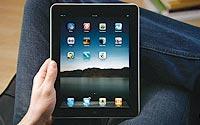Study: iPhones, iPads Have Distinct Usage, Users
- by Mark Walsh @markfwal, August 16, 2013
 It’s no
secret that people tend to use tablets mostly at home, while smartphones are used everywhere. New research from app advertising and analytics firm Flurry affirms that distinction, but offers insight
on differences in iPhone and iPad usage.
It’s no
secret that people tend to use tablets mostly at home, while smartphones are used everywhere. New research from app advertising and analytics firm Flurry affirms that distinction, but offers insight
on differences in iPhone and iPad usage.The findings are based on profiles Flurry has created in which device owners are assigned to different psychographic segments, based on their app use. With that in mind, iPhone users tend to be “on the move” people, like value shoppers, singles, new moms, business travelers and music lovers.
Value shoppers, for instance, use the iPhone to scan barcodes and find bargains, while singles and “hip urban lifestylers” use them to socialize. What audiences gravitate to the iPad? Think pet owners, small business owners, moms, casual gamers and home design enthusiasts.
Unlike new moms, who skew toward the iPhone, moms of older children shift toward tablets “to entertain and educate older children,” according to a blog post today by Mary Ellen Gordon, research director at Flurry and author of the study. People in the “parenting and education” segment also line up in the iPad camp.
iPhone and iPad users differ in usage and time spent on apps, Overall, iPad owners spent 43% more time in apps than their iPhone counterparts in May, but time varied significantly by category. iPhone users spent more than 13 times as much as time with navigation apps. They also spent five times as much time with health and fitness apps for tracking their walks, runs and bike rides. On the iPad side, people spent more time with apps that are conducive to at-home users, including education, newsstand, games and reference.
As might be expected with the rise of two-screen viewing, iPad use is heaviest in the evening, between 6 p.m. and 11 p.m. “iPhone app usage also peaks during that time, but the absolute amount of time on iPad and the percentage of app use that occurs during those hours is greater,” noted Gordon.
When it comes to late hours, however, the pendulum swings back toward the iPhone. The report suggests that may be a result of “insomniacs” reaching for phones at their bedside, or singles and urban hipsters finding their way back home late at night.
Of course, iPhone and iPad users aren’t mutually exclusive. More and more people own both devices. Flurry said that while its data doesn’t allow it to link the same user across different devices, it believes “individuals may express different parts of their personalities and lifestyles through their use of different devices.”
A single person, for instance, might use their iPhone for organizing their social life, but turn to an iPad to run their interior design business, putting that user in the small business and home design enthusiast categories as well. App developers and advertisers should consider contextual as well as audience differences in regard to the two Apple devices.
The findings were based on app use in May among a random sample of 44,295 iPhone and iPad devices on the Flurry network, which overall tracks app activity on 397 million iOS devices. The company plans to examine phone and tablet use on the Android platform in a future study.


